calsfoundation@cals.org
Arkansas State University (ASU)
Arkansas State University (ASU) is the only four-year public university in northeastern Arkansas. While grounded in a heritage of service to the region, the influence and impact of ASU’s teaching and research extend throughout the state and nation.
Arkansas State University had a humble beginning. On April 1, 1909, Governor George W. Donaghey signed Act 100, creating four district agricultural schools, culminating an initiative inspired by the Arkansas Farmers Union. On March 28, 1910, the trustees of the First District Agricultural School selected a farm just east of Jonesboro (Craighead County) as its location. Recruiting a leader to translate legislative authorization into educational reality, the trustees hired Victor C. Kays to be the school’s first principal. Although only twenty-eight, Kays was an experienced agricultural educator. He served as chief executive for thirty-four years.
Having hired Kays, the trustees awarded contracts for an administration building and two dormitories. However, opening the school could not wait for their completion. On October 3, 1910, in what had been Jonesboro’s Elks Lodge, the faculty and staff welcomed 189 students. The new school, affectionately known as Aggie, emphasized practical training in agriculture and home economics, and in 1913, its first graduates received high school diplomas.
The nation’s entry into World War I prompted a significant transition in the school’s history. Trustees Love Banks and Robert E. Lee Wilson obtained a Student Army Training Corps (SATC) detachment, but the program ended in 1918 shortly after the armistice. Nevertheless, the endeavor had long-lasting significance. Only junior colleges could participate in SATC, so the school hired additional faculty, expanded the curriculum, and launched an ambitious construction program greatly facilitated by contributions of materials, equipment, and labor from Wilson, who was a landowner and plantation manager in the region. The legislature confirmed this transformation in 1925 by changing the school’s name to First District Agricultural and Mechanical College. Subsequently, the North Central Association of Colleges and Secondary Schools accredited the junior college and conditionally approved a senior college curriculum.
Entering its third decade in May 1931, the A&M College awarded its first baccalaureate degrees. Tarnishing that milestone was a fire in January that destroyed the administration building. The insurance settlement proved insufficient to build a replacement facility, and the state’s financial distress stymied the sale of bonds. Determined to prevail, the board arranged financing and named the new building Wilson Hall to honor the influential trustee.
Using the art deco style of Wilson Hall as the architectural standard, the school constructed dormitories, classroom buildings, student support and operational infrastructure, and an athletic stadium. Acknowledging this maturation, the General Assembly in 1933 renamed the institution Arkansas State College (ASC), and the North Central Association accredited the senior college curriculum. The following year, the college recognized the support received from Senator Hattie W. Caraway by awarding her its first honorary doctorate.
While the 1930s witnessed steady growth, the next decade’s prominent themes were turmoil and transition for the college, especially with regard to enrollment and executive leadership. Enrollment at Arkansas State fluctuated dramatically as a result of World War II, dropping to an all-time low of 114 as students and faculty entered military service or took employment in war-related industries. Fortunately, several military training programs used the campus and enabled the school to remain open.
A post-war influx of veterans, whose education was facilitated by the G.I. Bill, caused enrollment to rebound to over 1,000. Housing and educating these students severely tested the college’s capacities and resources. Coping with these realities proved especially challenging because this was a period of administrative transition.
President Kays retired in January 1943, but he did not sever his association with the college. Rather, he became president emeritus and business manager. Over the next eight years, the college had two presidents, Horace E. Thompson (1943–1945) and William J. Edens (1946–1951), and between their terms Kays served as interim president. When the post became vacant again in March 1951, the trustees moved expeditiously and in less than one month announced the hiring of Carl R. Reng.
With the inauguration of Reng, Arkansas State College entered another period of administrative stability and witnessed development unrivaled in the school’s history. From an enrollment of less than 900, the school grew to over 3,000 by 1960. A corresponding expansion of the physical plant added dormitories, housing for married students, classrooms, athletic facilities, an administration building, a new library, and a student union—the Carl R. Reng Center.
The institution achieved another historic milestone during Reng’s administration. Reflecting the expansion of its academic programs, in 1955 the college began offering graduate-level courses and launched a campaign to obtain university status. In fact, the university’s radio station was inaugurated in 1957 with the call letters KASU in anticipation of achieving university status. This drive culminated in the introduction of a bill in the 1959 Arkansas General Assembly to change the college’s name to Arkansas State University. The legislative climate deteriorated, however, when the University of Arkansas (UA) in Fayetteville (Washington County) announced its opposition, and the bill did not pass.
The drive toward university status continued, and by the mid-1960s, support appeared to be approaching critical mass. President Reng, sensing the favorable political climate, initiated an intense and personal lobbying campaign in the months leading to the General Assembly’s 1967 session. This time, Arkansas State’s advocates prevailed, and on January 17, 1967, Governor Winthrop Rockefeller signed the act that changed the institution’s name to Arkansas State University.
Reng’s administration lasted eight more years, but this was a tumultuous period for the university, as Reng confronted social and political unrest. Although Walter Strong, Fred Turner, and Larry Williams integrated the student body in 1955, the faculty lacked minority representation until the hiring of Fred Turner in 1969 as an assistant professor of military science and tactics and C. Calvin Smith in 1970 as a history instructor. (Smith had earned his MA in history at ASU previously.) Moreover, persistent advocacy by the Black Student Association kept civil rights a prominent issue on campus for the remainder of Reng’s tenure.
Race was not the only element in the administrative cauldron. Reng also had to contend with student protests against the war in Vietnam, the questioning of his involvement with the Citizens Bank of Jonesboro, and the turmoil surround the nonrenewal of contracts for some pre-tenured faculty. As these disputes churned, however, Indian athletes achieved national recognition. The football team played in the college-division Pecan Bowl in 1968, 1969, and 1970, winning the national championship in 1970. Two years later, Thomas Hill, a hurdler at ASU, won a bronze medal at the Munich Olympics.
Reng retired in 1975. After twenty-five years of administrative constancy, Arkansas State had three presidents the following ten years: Ross Pritchard (1975–1978), Carl Whillock (1978–1980), and Ray Thornton (1980–1984). Eugene Smith’s elevation to the presidency in 1984 restored the customary stability. Indeed, Smith had deep institutional roots at ASU, having graduated from ASC in 1952 and returned in 1958 to join the faculty in the Department of Secondary Education. Subsequently, Smith served as dean of the Graduate School and as executive vice president. During his presidential tenure, which lasted until 1992, the university secured a doctoral program in educational leadership and moved to NCAA Division 1-A athletics.
Following Smith’s retirement, the university hired John Mangieri to be president, but this administration lasted only two years. His successor, Leslie Wyatt, became president in July 1995. Wyatt came to ASU from the University of Mississippi, where he had served as vice chancellor for executive affairs.
During Wyatt’s tenure, the university cultivated an area of concentration centered on the problems of the eastern Arkansas Delta region. Construction of new facilities has continued, the most notable additions being the Fowler Center (a performing arts facility), new student apartments, and an expansion of the student center. Moreover, Arkansas State University is now a system with campuses at Beebe (White County), Mountain Home (Baxter County), Newport (Jackson County), Heber Springs (Cleburne County), Marked Tree (Poinsett County), and Searcy (White County); an instructional site in Paragould (Greene County) operated from 2001 to 2019. In January 2015, ASU announced a planned merger with Mid-South Community College in West Memphis (Crittenden County); this was followed in 2019 by the announcements of mergers with College of the Ouachitas in Malvern (Hot Spring County) and with Henderson State University in Arkadelphia (Clark County). The university has also enhanced its research capabilities by becoming a partner institution in the Arkansas Biosciences Institute and launching additional doctoral programs in environmental science, heritage studies, and molecular biosciences. In an administrative reorganization, Robert Potts was hired as chancellor of the Jonesboro campus in the fall of 2006, while Wyatt retained the presidency of the ASU system as a whole. In 2010, Wyatt resigned, and Charles L. Welch, formerly the president of Henderson State University, was chosen to serve as system president. Tim Hudson was appointed chancellor of the Jonesboro campus in 2012 but resigned in 2016 following revelations of mismanagement in the study-abroad program, which his wife had overseen. The following year, Kelly Damphousse was named chancellor. He served until 2022, and Todd Shields was selected following Damphousse’s resignation.
In the early twenty-first century, the National Collegiate Athletic Association (NCAA) ruled that the use of Native American mascots and symbols by member institutions was “hostile and abusive.” In anticipation of the ruling, ASU had dropped most of its Indian symbols by 2006 while still retaining Indians as the name for sports teams and the like. In 2008, under threats of being banned from the NCAA champion competition, the school became one of the last in the nation to retire the Indian mascot and adopted the name the Red Wolves.
In 2015, ASU opened its new Humanities and Social Sciences building, as well as a new student activity center, and major renovations of Centennial Bank Stadium were also completed. The following year, the university completed renovation of Wilson Hall for use as an instructional site for the New York Institute of Technology’s College of Osteopathic Medicine the site opened with 115 students in the fall 2016 semester.
In late 2012, ASU began negotiations to build the first American university in Mexico. In early 2014, the private investors heading up the project announced that they had acquired land in Colón, Querétaro, and construction began soon afterward. The university in Mexico will open in several stages, beginning in 2017 with initial plans for 1,000 students, eventually reaching capacity for 20,000 by the end of twenty years of operation.
The total enrollment at ASU in the fall of 2021 was 12,863. Fall 2023 saw a record-setting enrollment of 14,903, followed by a fall 2024 enrollment exceeding 16,000. By the next year, it had neared 18,000.
In May 2023, the ASU Board of Trustees approved a plan for a College of Veterinary Medicine to be established on the campus in Jonesboro; the Arkansas Higher Education Coordinating Board approved the plan on July 28, 2023. The college will offer a Doctor of Veterinary Medicine (DVM) degree, the only one of its kind in Arkansas.
In September 2023, ASU announced its new A-State Promise Plus scholarship program to provide free tuition for qualifying Arkansas first-year students whose families have a yearly household income of $70,000 or less; the scholarship covers any tuition costs not covered by federal grants or other scholarships. Students who qualify also receive a stipend for room and board if they live on campus.
For additional information:
Arkansas State University. http://www.astate.edu (accessed September 12, 2024).
Ball, Larry D., and William M. Clements. Voices from State: An Oral History of Arkansas State University. State University: Arkansas State University Press, 1984.
Dew, Lee A. The ASU Story: A History of Arkansas State University, 1909–1967. Jonesboro: Arkansas State University Press, 1968.
Dunivan, Major James. “A Symbiotic Alliance: Arkansas State College and the United States Army, 1935–1950.” Arkansas Review: A Journal of Delta Studies 37 (April 2006): 14–29.
Embrace the Past 1909–2009: Celebrating Our First Century, Arkansas State University. Jonesboro: Arkansas State University, 2012.
Hartness, Richard, Sr. The Circle: Coping with Integrated Life at Arkansas State University: In the Community and at Home, 1970–1978. Jonesboro, AR: GrantHouse Publishers, 2016.
Newsom, Glenda. “Biography of Dr. Eugene W. Smith: Arkansas State University President, 1984 to 1992.” EdD diss., Arkansas State University, 2012.
Willis, James F. “The Farmers’ Schools of 1909: The Origins of Arkansas’s Four Regional Universities.” Arkansas Historical Quarterly 65 (Autumn 2006): 224–249.
Brady M. Banta
Arkansas State University









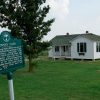








 A&M College Arch
A&M College Arch  Arkansas Biosciences Institute (ABI)
Arkansas Biosciences Institute (ABI)  Arkansas State University Library
Arkansas State University Library  Arkansas State University
Arkansas State University 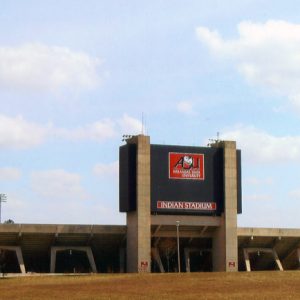 Arkansas State University Indian Stadium
Arkansas State University Indian Stadium 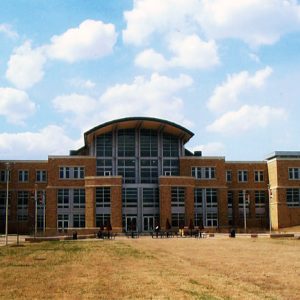 Arkansas State University Student Union
Arkansas State University Student Union  ASU Runnin' Joe" Mascot
ASU Runnin' Joe" Mascot  ASU Bulletin, 1959-60
ASU Bulletin, 1959-60  Magnolia A&M vs. Arkansas State Program
Magnolia A&M vs. Arkansas State Program  ASU Rugby Team
ASU Rugby Team 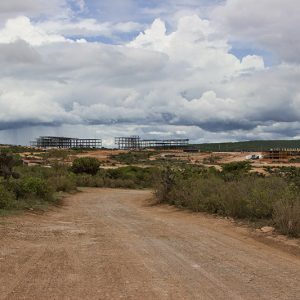 ASU Mexico
ASU Mexico  ASU Mexico T-shirt
ASU Mexico T-shirt 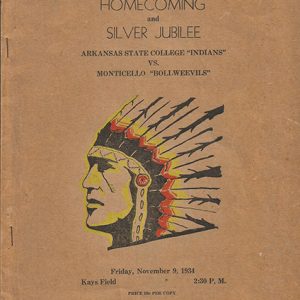 ASU Homecoming Program
ASU Homecoming Program  Arkansas State University Museum, circa 2008
Arkansas State University Museum, circa 2008  Museum Interior, 1940s
Museum Interior, 1940s  Arkansas Statehood Stamp Program
Arkansas Statehood Stamp Program  ASC Campus
ASC Campus  1970 ASU Football Team
1970 ASU Football Team  ASU Miss Arkansas Contestants
ASU Miss Arkansas Contestants 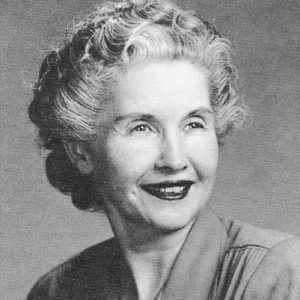 Sudie Barnett
Sudie Barnett  Earl Bell
Earl Bell  FDSA School Admin. Building
FDSA School Admin. Building  Victor Kays
Victor Kays  Larry Lacewell
Larry Lacewell  Lakeport Plantation Meeting
Lakeport Plantation Meeting 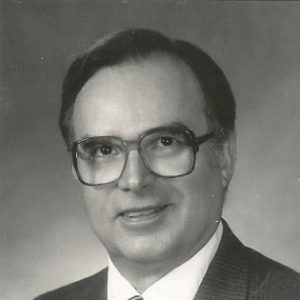 Eugene Smith
Eugene Smith  Summer Session at First District A&M
Summer Session at First District A&M  Ray Thornton Jr.
Ray Thornton Jr.  Ike Tomlinson
Ike Tomlinson  Charles Welch in Mexico
Charles Welch in Mexico  Carl Whillock
Carl Whillock  Wilson Hall
Wilson Hall 



Comments
No comments on this entry yet.